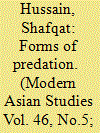| Srl | Item |
| 1 |
ID:
118911


|
|
|
|
|
| Publication |
2012.
|
| Summary/Abstract |
In this paper I compare late nineteenth and early twentieth-century sport hunting of markhor, a mountain goat, by British civil and military officials in the mountainous northern frontier region of Kashmir State, with their hunting of tigers, particularly man-eating tigers in the hilly and plains regions of India. Using these two instances, this paper elucidates and compares two competing visions of colonial governance. The British sportsman hunted man-eating tigers in order to protect Indian society from wild nature. Hunting them was also symbolic of their welfare-oriented governance ideology. They also hunted markhor in the northern mountainous region using begar, or forced labour, which they justified by falling back on the wider colonial representation of the northern mountainous region as a civilization-less area, where a more coercive form of governance was needed. So, rather than protecting society from nature, as in the case of man-eating tiger hunting in the plains, what was needed in the mountains was the ability of the British to introduce civilization into unruly nature via a strong disciplinary force. I argue that colonial governance entailed not simply a struggle to civilize India and its population, but a more profound struggle for control over nature.
|
|
|
|
|
|
|
|
|
|
|
|
|
|
|
|
| 2 |
ID:
072980


|
|
|
|
|
| Publication |
2006.
|
| Summary/Abstract |
In their rocky defiles their chiefs led the lives of absolute autocrats; the slave-trade flourished, and the ruler of Hunza, especially, whose territory led up to the foot of the comparatively easy passes leading to the Pamirs and the valley of the Yarkand river, found the looting of the rich caravans on the trade route between Central Asia and India a source of wealth. For centuries the name of the Hunza-Nagar men had struck terror into the hearts of all travelers in the country between Afghanistan and Kashgar.
|
|
|
|
|
|
|
|
|
|
|
|
|
|
|
|